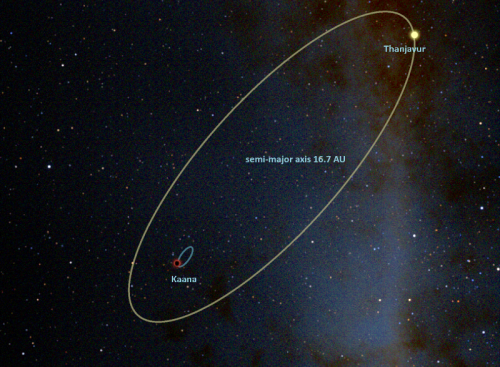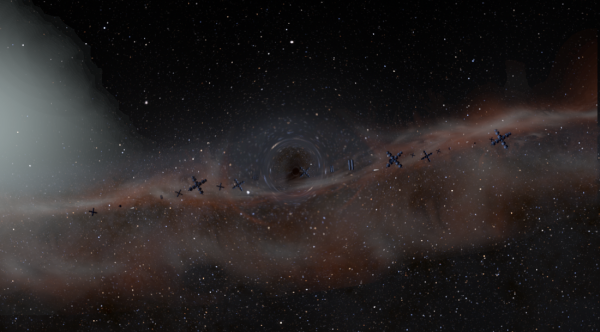BY LETTER
Kaana (Gaia BH3)
Galactography > Sephirotic Empires > Keter Dominion
Galactography > Regions of Space > Middle Regions/Hinter-regions
Galactography > Systems and Worlds > Systems & Worlds K - L
Galactography > Regions of Space > Middle Regions/Hinter-regions
Galactography > Systems and Worlds > Systems & Worlds K - L
Large stellar-mass black hole in Aquila | |
 Image from Steve Bowers | |
| Kaana is a black hole with a mass of 32.7 x that of Sol. It has a radius of 96.6 km, and is in a distant orbit around Thanjavur, an unrelated ancient star with very low metallicity | |
Kaana Data Panel | |
| Kaana | Names: Kaana, Gaia BH3, LS II 14 13 Stellar Type: Black Hole Mass: 32.7 x Sol Radius: 96.6 km Age: approx. 13 billion years Constellation: Aquila Distance from Sol: 1930 ly Right ascension: 19h 39m 18.71s Declination: +14° 55′ 54.01 |
|---|---|
| First Reached | 5510 AT |
| Notes | Kaana was a supergiant star that went supernova 12 billion years ago, in a minor galaxy near the Milky Way. Although it was captured at the same time as Thanjavur these stars were not previously associated with one another. |
 Image from Steve Bowers | |
| Kaana is in a binary system with the star Thanjavur, which has a mass of 0.76 x Sol, but a diameter five times as great. Thanjavur is a very old star that formed in a minor galaxy, and was captured (along with the black hole) by the Milky Way billions of years ago | |
Thanjavur Data Panel | |
| Thanjavur | Stellar Type: G type (low mass, very old, subgiant, low metallicity - mostly hydrogen and helium) star Mass: 0.76 x Sol Radius: 4.9 x Sol Age: approx. 13 billion years |
|---|---|
| Notes | Thanjavur is part of Halo Stellar Stream ED2, a remnant of a former galaxy. It was captured by the Milky Way about 5 billion years ago |
Kaana was once part of a minor galaxy relatively close to the Milky Way. The original three stars that formed this system were all huge, low density Population III stars; two of which were in a binary relationship with each other, and both of these became supernovae and collapsed into black holes. After a billion years or so these two black holes merged to form Kaana, which (at 32.7 solar masses) is one of the heaviest black holes in the Orion Spur. Later this massive object was captured by the Milky Way, and during this chaotic process Kaana gained a companion (Thanjavur), another very old star with extremely low metallicity.
Kaana was a prime objective for exploration and colonisation, and a joint Biovirate/Cygexpa mission reached there in 5510 AT. However the process of colonisation was still underway when the Biovirate declared war on the Keter Dominion. The Biovirate was an aggressive minor empire, but no match for Keter, and by 6009 AT the war was over. Although the Kaana system saw no fighting, a Keter Dominion ISO arrived in 6030 to assume control over the system.
For over a thousand standard years the system was run as a joint colony by Cygexpa and Keter, but then the Cygexpa empire voluntarily disbanded itself and handed over full control to Keter, including the wormhole connection which had arrived just after the Biovirate war. Since that time this system has been solely controlled by the Keter Dominion. As such it is home to a very significant population of transapients, and Thanjavur is now home to a S:4 archailect.
Kaana God-dwellers
Kaana was surrounded by a thin accretion disk, a remnant of the ancient supernovae events; this disk has now been thoroughly exploited and converted into processing nodes, moonbrains and godtech manufacturing complexes.However many of these structures are configured so that they can support a population of modosophonts; originally these were the descendants of Cygexpa and Biovirate citizens, largely bionts of various kinds, and they were accommodated in extreme comfort and afforded every opportunity to enjoy the benefits of advanced Sephirotic society. A significant fraction of these inhabitants later ascended to transavant or transapient status, either singly or as S:1 tribe minds. Among the structures in this system are a number of Ascension Mazes, including a few which do not advertise their nature.
However a large majority of the inhabitants of this system did not ascend, and instead remained in the system as worshippers, observers and god-dwellers of various kinds. Most of these inhabitants are virtual sophonts, living in a range of virtual utopias or in exciting and challenging adventure virches. These dwellers often interact with various levels of avatar created by the local transaps and archailect.
The local transingular entities also routinely create large numbers of figments, semi-autonomous sophonts which live independent lives from their creator, but can be reabsorbed by them at a moment's notice without loss of data. This means that the total population of the Kaana system can be quite high on occasion, although it does fluctuate wildly. Since the life of a god-dweller is so attractive, a steady stream of new modosophonts arrive every standard year, and some of these eventually become transapients.
 Image from Steve Bowers | |
| Kaana Accretion Disk is home to many sophisticated and enigmatic structures, some of which are apparently Ascension Mazes | |
Time travel to the future
Because the Kaana black hole is so large compared to other examples in the Terragen Sphere, it can be utilised to a certain extent as a one-way time machine. Small, compact dataships sometimes orbit very close to the event horizon, sometimes within the ergosphere, where time passes much more slowly than elsewhere. At any one time several thousand timeships are currently wending their way to the future, subject to both time dilation and length contraction.Related Articles
Appears in Topics
Development Notes
Text by Steve Bowers
Initially published on 13 June 2024.
Initially published on 13 June 2024.
Additional Information
More details on Gaia BH3:
https://en.wikipedia.org/wiki/Gaia_BH3
https://en.wikipedia.org/wiki/Gaia_BH3






